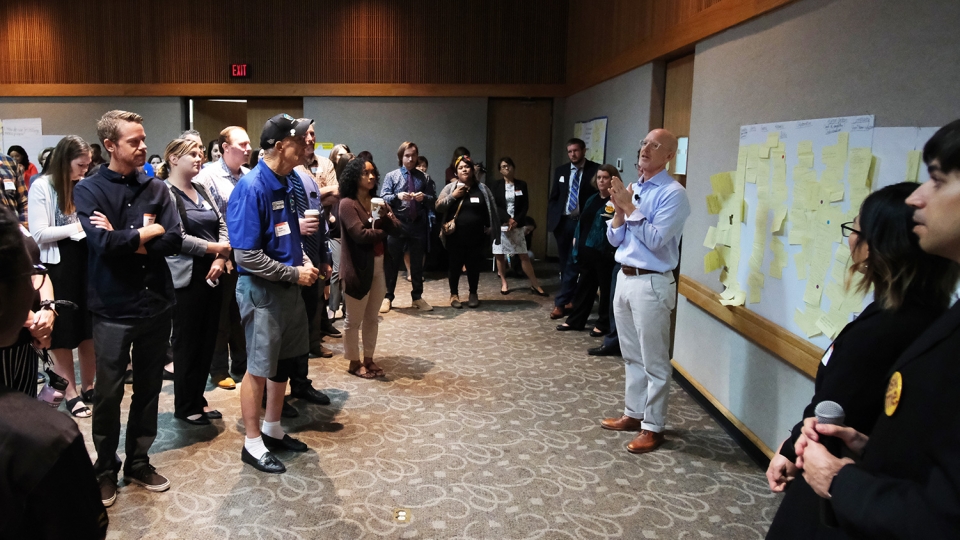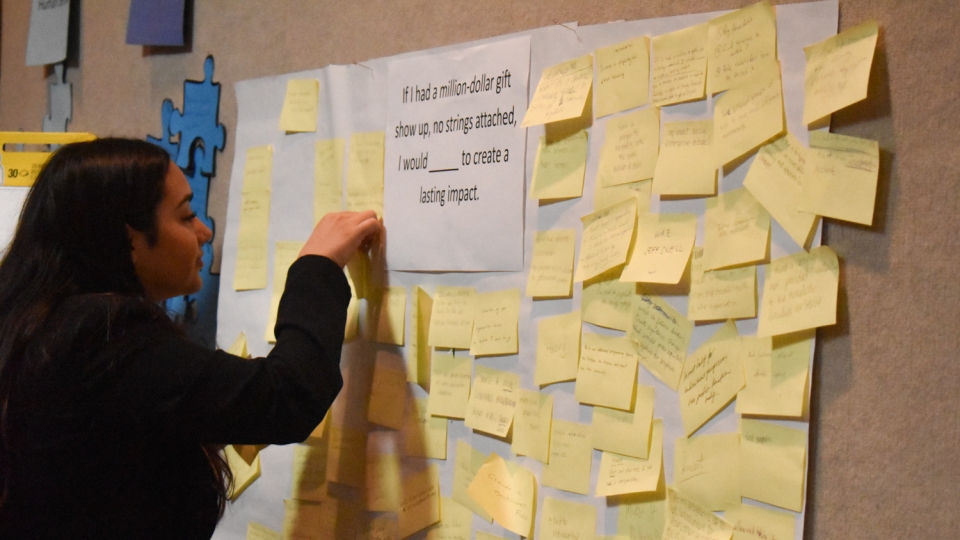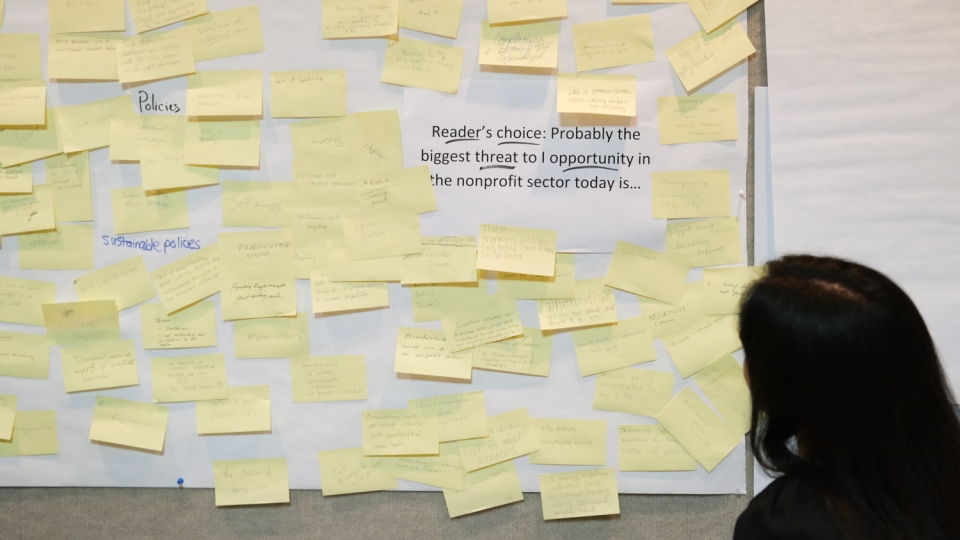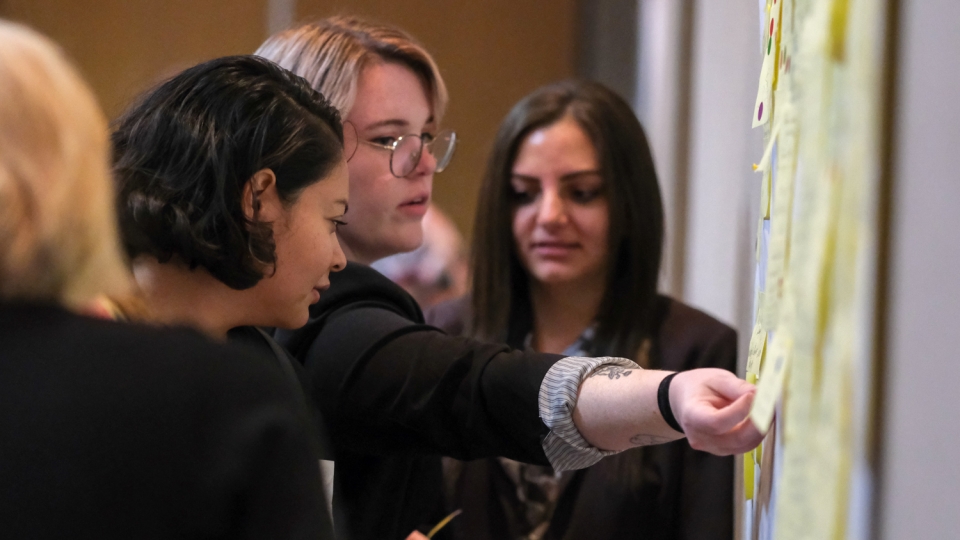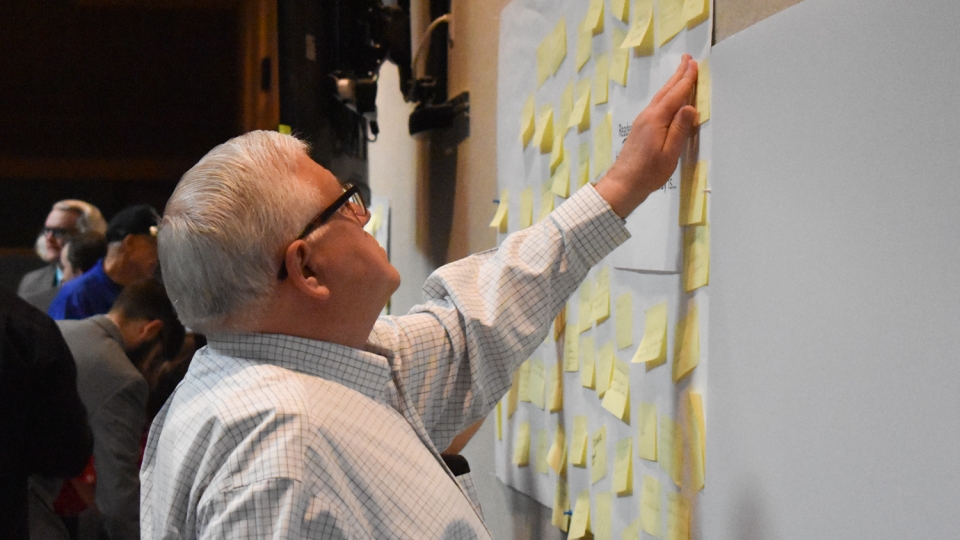
The 2019 Solutions Collaboratory
The 2019 Solutions Collaboratory
Voices of the nonprofit sector
For our 27th annual fall conference in Phoenix, we wanted to try something new, something collaborative, something that leveraged the energy and ideas of the hundreds of nonprofit professionals gathered in one ballroom.
And so we conceived The UnConference: CommYOUnity Solutions, a space to give voice to the key issues in our nonprofit and philanthropic community and to collectively find real solutions to these shared challenges.
During the morning-long Solutions Collaboratory, Jeff Snell, the Sr. Fellow for Social Innovation at the ASU Lodestar Center, guided the UnConference participants through an interactive exercise designed to surface the major, shared issues in the sector – and, critically, to talk through ideas for solutions. Snell posed six big-picture questions, handed out sticky notes and tasked everyone with writing down responses. Student volunteers at each station then grouped the notes into categories that guided the discussion; afterwards, participants used brightly colored stickers to vote for the answers that most resonated.
All of the responses that received votes have been reproduced below, a snapshot of our sector's hopes and fears, triumphs and failures, opportunities and challenges.
To close the Collaboratory, David Bornstein of the Solutions Journalism Network and The New York Times shared his thoughts on the day's key themes. Bornstein's work looks at how people and organizations respond to social problems, providing insights and evidence of results that others can use. He encouraged attendees to continue this process – of confronting problems and seeking solutions – at their organizations. "The last thing we need is more leaders who are not self-reflective," he said.
And now, here are the results of the ASU Lodestar Center's 2019 Solutions Collaboratory.
Votes8 |
Community partnerships were easier to navigate |
Votes7 |
We could collaborate more to maximize impact |
Votes5 |
Didn’t see each other as competition but collaborators for greater impact |
Votes5 |
Collaboration working together to expand and grow |
Votes3 |
We created more win/win partnerships |
Votes2 |
We had more partnership and collaboration to move the needle on policy |
Votes2 |
More collaborative partners |
Votes1 |
Collaborate together to provide more resources |
Votes1 |
Build community within the sector |
Votes1 |
Worked together, not compete against |
Votes1 |
Be less competitive and more collaborative |
Votes1 |
More collaboration, more "water cooler conversations" |
Votes1 |
Collaborate, not compete |
Votes1 |
There were more collaborative efforts across the board |
Votes1 |
True collaboration |
Votes1 |
Collaborate together to provide more resources |
Votes12 |
We could lobby together to better address root causes on a policy level rather than create programs that address symptoms |
Votes2 |
We were involved in more advocacy together |
Votes6 |
Similar organizations would merge together |
Votes4 |
Nonprofits merge to achieve economies of scale |
Votes4 |
Organizations would consolidate to concentrate impact |
Votes5 |
The “that’s not my job” mentality was gone |
Votes1 |
There was more personal accountability |
Votes3 |
Nonprofits were taught how to spend money |
Votes1 |
Fundraising worked together |
Votes1 |
We had the funds to grow and achieve our core values |
Votes2 |
We could focus on our assets |
Votes1 |
We could eliminate homelessness |
Votes1 |
Abide by best practices |
Votes1 |
They invest more in branding, communications and marketing |
Votes1 |
We worked directly with beneficiaries |
Question #2
"If I had a million-dollar gift show up, no strings attached, I would _____ to create a lasting impact."
Votes15 |
Invest in my employees |
Votes4 |
Hire and train more nonprofit professionals |
Votes4 |
Invest in people |
Votes3 |
Halt operations for one month to focus on staff, vision and overall heal the organization |
Votes2 |
Build capacity, additional staff, training/professional development |
Votes1 |
Invest in organizational infrastructure to be able to expand |
Votes1 |
Set my programs up to be sustainable for years then be able to focus revenues also on new programs that are needed |
Votes7 |
Invest in future leaders, create systematic change that would more equitably fund systems for long-term change |
Votes2 |
Educate our future leaders on the importance of nonprofit work |
Votes2 |
Take different groups of kids to new and different environments |
Votes2 |
Invest in early education (pay for tutors, teachers and supplies) |
Votes1 |
Scholarships for nonprofit leaders to further education |
Votes1 |
Increate visibility of the important role of nonprofits play throughout or community using widespread public campaigns |
Votes1 |
Train and provide education for better volunteerism leadership |
Votes7 |
To create lasting impact I would use 1 million to develop an interface that allows nonprofits/agencies to share resources and opportunities |
Votes1 |
Fund a merger for nonprofits with the same mission & vision |
Votes1 |
Create a collaborative effort between all three sectors |
Votes1 |
Invest & fund problem-solving programs |
Votes1 |
Fund collaboration effort to close income gap |
Votes1 |
Collaborate with other leaders in the nonprofit sector |
Votes5 |
Start an endowment that started an open grant cycle focusing on solutions for cross-sector collaboration |
Votes2 |
Build the endowment fund, fund the greatest need |
Votes2 |
Create an endowment fund |
Votes1 |
Create an endowment |
Votes2 |
Housing |
Votes2 |
Create integrated housing and job training program |
Votes2 |
Build senior housing continuum of care community in phoenix |
Votes1 |
Fund a program that provides housing to the homeless families |
Votes1 |
D.V. shelter for LGBTQ individuals |
Votes3 |
Use it to lobby the state government to change the way K-12 education is funded – to equal distribution of property taxes in a county to each school, to level the playing field of “poor performing” schools, because education for all is the key |
Votes3 |
Fund progressive advocacy |
Votes5 |
Invest in and support local nonprofits by means of trust funds to keep money over time |
Votes5 |
Invest in youth programs |
Votes4 |
Create a social/sustainable entrepreneurship program in ___’s business school |
Votes1 |
Invest, fund & support local nonprofits by means of trust funds to keep money over time |
Votes1 |
Invest it, grow it, contribute to innovative strategies for social change |
Votes1 |
I would establish a foundation for the purpose of ending the education gap for low income students, spend the first year planning, ensure sustainability of the funding |
Votes2 |
Prevention |
Votes1 |
Long term evaluation |
Votes1 |
Hire Jeff Snell |
Votes1 |
Give money to low-income people |
Votes1 |
Give to parents or students in need who find selves in a cycle of poverty/financial stress towards goals to get out of cycles |
Question #3
"The biggest threat/opportunity to the nonprofit sector today is..."
Votes15 |
Lack of diversity in leadership |
Votes2 |
Lack of diversity |
Votes1 |
No diversity, forgetting the mission |
Votes6 |
Competition outweighs collaboration |
Votes4 |
Competition versus collaboration |
Votes1 |
Competitiveness between nonprofits |
Votes1 |
Oversaturation of market. Too many cooks in the kitchen not enough collaboration |
Votes1 |
Competition, no intergenerational collaboration |
Votes2 |
Overwhelming needs, not enough resources both monetary and human capital |
Votes2 |
Funders not allowing “true cost” program budget |
Votes1 |
Diluted resources |
Votes1 |
Lack of funds and interest to help others through selflessness |
Votes1 |
Fragmented giving |
Votes1 |
Loss/lack of financial vision |
Votes1 |
Ongoing funding |
Votes1 |
Fear of losing/not getting funding |
Votes1 |
Dwindling support |
Votes1 |
The amount of nonprofits attempting to solve the same issue because of limited resources |
Votes4 |
Risk aversion |
Votes1 |
Concentrating on negative vibes |
Votes1 |
Doing things the same way |
Votes3 |
G.O.P. |
Votes2 |
New tax law and hostile federal government |
Votes4 |
Lack of education of how NPOs work/function |
Votes5 |
Negativity (pessimists) |
Votes5 |
The illusion of business |
Votes4 |
Losing touch with communities they serve |
Votes3 |
Threat – thinking just your organization along can’t make an impact |
Votes2 |
Selfishness |
Votes2 |
Lack of communication efforts: utilizing modern tech efficiently |
Votes2 |
Nonprofits not operating like a business and therefore not attracting bright, motivated, driven minds |
Votes2 |
Win, winism |
Votes2 |
Ignoring systemic problems for the sake of positivity |
Votes2 |
Inconsistency in fundraisers/staff and volunteers
|
Votes1 |
Social media |
Votes1 |
Capacity |
Votes1 |
Sustainability |
Votes1 |
Lack of education of leadership and donors |
Votes1 |
Employees leaving the field for higher wage jobs/change of career |
Votes1 |
Lack of equality |
Question #4
"Legit leaders in the nonprofit sector focus on...."
Votes11 |
People |
Votes7 |
Their team and recipients of service |
Votes3 |
Relationships |
Votes2 |
Inspiring people |
Votes1 |
Serving the people |
Votes16 |
Culture |
Votes7 |
Collaborating instead of competing |
Votes2 |
Collaborative solutions |
Votes1 |
Collective collaboration to complement the work of other organizations in the community |
Votes1 |
Collaboration, facilitation, empathy, listening, kindness |
Votes1 |
Partnerships |
Votes1 |
Communication & collaboration between sectors |
Votes6 |
Mission/impact |
Votes2 |
Driving the mission |
Votes1 |
Impact, long-term, big picture |
Votes1 |
Their mission and vision grassroots driven |
Votes1 |
Equity. Advocacy. Access, achieving purpose/vision and planning for sustainability of the agency |
Votes1 |
Vision, empowering team |
Votes5 |
Educating staff and empowering volunteers to best express and utilize their talents and gifts |
Votes1 |
Enabling their team to be a community asset |
Votes1 |
Building other leaders and empowering collective action to maximize impact |
Votes1 |
Building up other/next generation leaders |
Votes1 |
Developing emerging leaders in the sector |
Votes1 |
Educating youth on the impact of nonprofit work |
Votes3 |
Impact |
Votes1 |
Determining impact and measurement |
Votes1 |
The outcomes for those they serve |
Votes1 |
Long-term impact and measurement |
Votes6 |
Systematic change |
Votes5 |
Working for their community |
Votes2 |
Finding practical and inclusive solutions |
Votes1 |
The roots of the problem to find solutions |
Votes1 |
Innovative ways to address problems and be pro-active |
Votes3 |
Work-life balance |
Votes3 |
Being inclusive |
Votes5 |
Listening |
Votes3 |
Reality and hope |
Votes3 |
The assets a community already has and have to unite those assets first by outside help |
Votes3 |
Financial Sustainability |
Votes2 |
Action |
Votes2 |
Welcoming new ideas and solutions that can advance the mission and goals of the org |
Votes1 |
Tomorrow |
Votes1 |
Conflict resolution/management |
Votes1 |
Getting the work accomplished |
Votes1 |
Productivity |
Votes1 |
Their real passion |
Votes1 |
Manage risk taking |
Votes1 |
Authenticity in their words and actions |
Votes1 |
Reforming the corporate sector |
Question #5
"Why do some social problems persist?"
Votes15 |
We focus on symptoms, not causes/roots |
Votes6 |
Failure to address the root cause |
Votes3 |
We create boundaries rather than long-term solutions |
Votes1 |
Complexity: what are causes, what else impacts, how to ensure long-term support to solve, how to decide the solution |
Votes1 |
They persist because we all think in sound bites and short term |
Votes1 |
Not enough emphasis on prevention |
Votes5 |
Systemic inequality |
Votes3 |
Inequity |
Votes3 |
Social injustice and social inequality |
Votes3 |
Infrastructure/systematic inequality |
Votes3 |
Fear and ignorance |
Votes3 |
Racism and implicit bias |
Votes1 |
Generational social injustice |
Votes1 |
Isolation, “what can I do?” mentality |
Votes1 |
Stigma |
Votes1 |
Discrimination against minority groups, especially people who have disabilities |
Votes9 |
Money, power, want to keep money and power |
Votes5 |
Broken systems |
Votes3 |
Lack of action from our president and congress |
Votes3 |
Capitalism |
Votes1 |
Fake news |
Votes10 |
They benefit people with the most power/resources |
Votes2 |
Lack of empathy |
Votes2 |
Humans |
Votes2 |
Denial & selfishness/self-preservation |
Votes1 |
Lack of care, it doesn’t affect them personally |
Votes1 |
Social problems persist because too much focus is placed on profit and power over people and basic human needs |
Votes2 |
Equal access to education |
Votes2 |
Cycle of poverty/generational poverty, unequal opportunities in early life, Addressing the symptoms but not the root cause/issue |
Votes2 |
Poverty |
Votes1 |
Poverty without hope or optimism |
Votes2 |
Lack of funding |
Votes1 |
Problems persist because funding is not long term |
Votes2 |
Lack of perspective and POA |
Votes1 |
Lack of consensus on how to solve them |
Question #6
"What is the purpose of leadership education for nonprofit executives?"
Votes5 |
Innovation, thinking outside the box |
Votes4 |
Bigger thinking |
Votes2 |
To motivate/inspire leaders to be innovative in how work is delivered |
Votes2 |
Allowing for other thoughts and new ways of solving problems |
Votes1 |
To help them remain effective and create innovative solutions to keep up with growing needs. Get out of the “this is the way we’ve always done it” mindset |
Votes5 |
To share and pick up new ideas/approaches to old problems |
Votes2 |
Provide knowledge and establish expectations |
Votes1 |
To develop more good leaders in nonprofits |
Votes4 |
Growth, continued change and improvement to reach more |
Votes3 |
To grow and evolve |
Votes4 |
Leaders are learners too |
Votes1 |
New ways of thinking, innovate new models of fundraising |
Votes4 |
To keep the table legs of the organization stable |
Votes1 |
Sustainability |
Votes1 |
Networking with those who fully commit to organization mission, vision and values |
Votes1 |
Society is always shifting, so it is important to know the who, what, when, where and why when it comes to serving as a leader. It’s important to stay updated |
Votes1 |
Really – you have to justify this |
What comes next?
We were delighted by the response to our UnConference and by the data that emerged. In 2020, look for our programming to incorporate many of these themes, from more collaboration to investing in your people. Subscribe to our newsletter for updates from us twice a month.
Photo: On stage, Jeff Snell (left) and David Bornstein shared their observations about the Solutions Collaboratory.
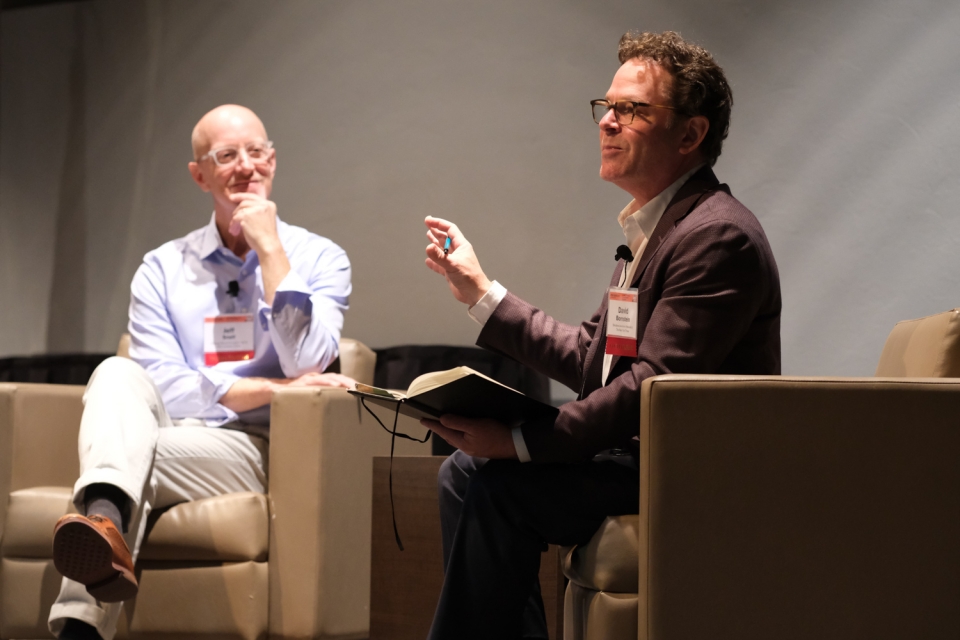
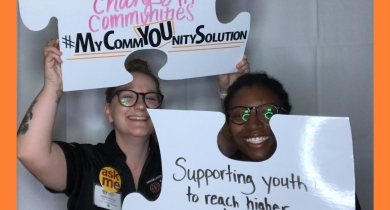
#MyCommYOUnitySolution
See our community's ideas from The UnConference photo booth
What's your idea to make a difference? That's the question we posed to attendees at the 2019 UnConference's photo booth. See what this diverse group of nonprofit professionals, community members and students had to say.
